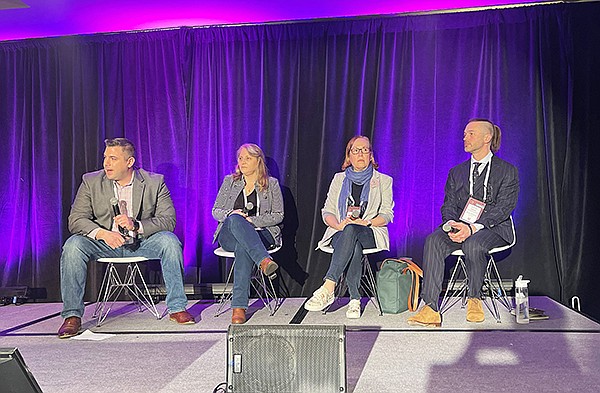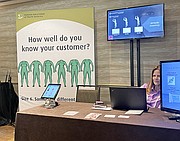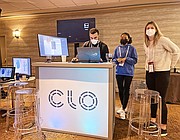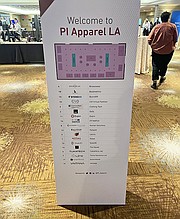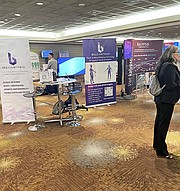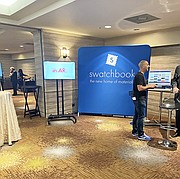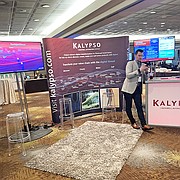PI Apparel Los Angeles 2022 Showcases Latest Apparel-Industry Technology
PI Apparel
(Left to right) Lenny Marano, President of the Americas, Gerber Technology & Lectra; Adi Mandel, Marketing Manager, Twine; June Evans, Director of Technical Design, Filson; and, Jeffery Diduch, SVP Design, Technical, Hickey Freeman Tailored Clothing | Photo by Betti Halsell
As of Thursday, March 31, 2022
After the pandemic changed the nature of many businesses to embrace more-virtual settings, apparel companies and manufacturers have increasingly been looking for new and innovative technologies to help better serve clients and customers. PI Apparel Los Angeles 2022 took place at the Westin Bonaventure Hotel & Suites in downtown Los Angeles March 15–16, bringing together leaders from the apparel and footwear industries to discuss the challenges and technologies disrupting the industry.
After opening remarks from Safir Bellali, senior director of advanced digital creation at VF Corporation,who also served as chairperson of the event, guests were able to browse the exhibitor show floor and attend panel discussions on 3D technologies, digital assets and virtual fitting, NFTs, the metaverse and Web3, sustainability, the new shopping experience featuring AR and VR elements, and more.
“The whole idea of the metaverse is important right now because a lot of brands are trying to understand what their presence in the metaverse should be,” Bellali said. “They understand there is an opportunity to step into the space and opportunities to have a voice. There are also financial opportunities. There are new digital marketplaces that are opening up, and I think that’s going to create some really interesting shifts in our industry.”
During the Integrating 3D Technology Across the Entire Product Lifecycle session, Hidi Fankhauser and Christl Schad of Design Works discussed how 3D technology can impact all aspects of the product life cycle.
Fankhauser noted how 3D can save time in three different phases of a product: between designers and merchandisers, during design handoff to technical designers, and during the development phase. Using 3D technology can also reduce the length of the traditional prototype process, which can normally take three to six weeks, to just a matter of days depending on the type of product. Time and money are also saved during the sizing process as there is no need to create physical samples nor utilize models or dress forms.
A hot topic of discussion at this edition of PI Apparel was NFTs and the metaverse. Many of the panels and keynote speeches discussed the uses of NFTs and the metaverse and how brands can adapt those uses to drive engagement and better connect with customers. The NFT Mechanics and Ideations session featured guest speakers Eric Holdener, CEO of Kinestry, and Rachel Victor, director of strategic insight and user experience of Kinestry, who discussed ways apparel brands can get into the NFT and the Web3 space.
The How Can We Leverage More Sustainable Practices to Increase the Bottom-Line, Market Share & Consumer Engagement? panel discussed how to reconcile the high costs of making sustainable products while keeping consumer-friendly prices. Another topic covered was the responsibility of brands to help educate the consumer on which products are actually sustainable and not an example of greenwashing.
On the second day, footwear specialist Sean Scott, who had a hand in the growth of TOMS shoes, was a keynote speaker at Looking to the Future of Decentralized Manucfacuring & Local Production. Scott is the co-founder and CEO of the COMUNITYmade brand, and he is well experienced in sourcing locally while looking out for the well being of the surrounding community.
Scott elaborated on the benefits of domestic manufacturing and how for so long the industry has been looking at the world of manufacturing the wrong way.
“Simply making a fair profit for your shareholders is not enough. And that was a whole perspective shift for us,” Scott said. “I’m a big fan of limitations driving creative innovation. I think it is much more effective. I just wanted to make the best shoes I could have the best value, but in doing so, whether I understood it or not, I was incentivized to keep labor costs down. I was incentivized to impress them,” Scott explained.
Lenny Marano, President of the Americas, Gerber Technology & Lectra, kicked off the panel discussion No Waste, No Problem: Digitize Fashion Across Your Entire Value Stream to Allow Your Company to Be Sustainable and Profitable by stating that the fashion space is evolving and meeting needs is going to be key.
“We’ve heard a lot about inclusivity over the course of the last few days—being able to adapt to market needs. Personalization, customization are going to be really mandated by our customer metrics,” Marano said. “We are going to see that continue to grow in corporate social responsibility.”
Tiffany Radon and Mark Charlton from Carhartt Inc. guided the conversation at the Gender Relevance for Apparel Sizing & A Non-Binary Approach session. Charlton started the presentation with the headline “Style Has No Gender.” With the Gen Z consumer, “there’s an interesting shift of removing the delineation of gender,” Charlton said.
A key factor in this discussion was that non-binary clothing is less of a trend and more of a movement, with Gen Z making up 32 percent of the world’s population and having spending power in the U.S. alone of over $143 billion.
In addition to the educational talks and sessions, the exhibitor floor at PI Apparel showcased some of the latest upcoming technologies in the apparel space, including FIT:MATCH, Browzwear, The Squad Nation, CLO, Human Solutions, VNTANA,and others.
FIT:MATCH representative Justice Jackson explained that the company’s technology offers the opportunity for apparel brands to match their customers with the best-fitting products, significantly reducing returns while driving conversion and brand loyalty.
“What we’re doing is monumental in the fashion industry,” Jackson said. “Essentially what we’re doing is taking the new iPhone and using their LiDAR technology to take body scans—creating an all-inclusive experience for everyone.” Jackson added that the data from each scan are completely private.
Browzwear Business Development Manager for Education (North America) Krista Lippert explained the digital assembly line for design, manufacturing and sales programmed into the cmpany’s technology.
“When you create something in 3D, it can be used throughout the entire process that a designer or a brand might go through—not just design but thinking about manufacturing,” Lippert said.
The significance of digitizing the manufacturing experience is that it greatly reduces the carbon footprint in production, Lippert explained. “The whole process is with one file, and when you get to e-commerce, what customers are seeing, you have that same file that you can put out to the world.”
CEO of The Squad Nation Stephanie Muhlenfeld shared that connection is the cornerstone of her business. The company provides client acquisition and partnerships for brands looking to outsource certain digital and creative aspects of their business to people under The Squad Nation umbrella working remotely.
“The Squad Nation was built on the belief that people should be dispersed and live wherever they want to live, giving them responsibility and authority back over their own lives—we were before the curve [COVID-19]. We already had our infrastructure set to have a remote team.”
Vice president of business development for the 3D fashion software company CLO, Ryan Teng, explained the bridge between apparel and the future of a virtual world. “CLO is a company that is working to have a creative tool—to be able to create things in 2D and 3D and help people make more important decisions without making physical samples.”
Representative Melinda Miller from Human Solutions, which offers body-measurement data and ergonomic-design simulation in CAD, said the company is making size and fit optimization readily accessible to the apparel industry.
“I came on board because I believe in what [Human Solutions] does,” said Miller. “It’s science based—doing technical body scans so you actually have a real understanding of what America looks like.”
VNTANA has worked with Hugo Boss, Staud and Diesel, among others, and makes it easy for brands to upload, embed and share 3D and augmented-reality assets. According to co-founder and CEO Ashley Crowder, “having 3D on your e-commerce site and being able to view, turn and look at it from every angle alone has proven to increase conversion rate because it gives people a better understanding of the product in addition to increasing cart size and reducing returns.”
John Havens, who spoke on the Business of Sustainability panel, was browsing the exhibitor floor and speaking with people about his campaign, Planet Positive 2030, to get people to begin thinking with a more earth-positive mindset as just becoming carbon neutral isn’t enough to begin making an impact on the earth.
Along with Havens was Gabrielle Aruta, an art-gallery owner and art buyer who was interested in matching companies with international artists to create impact NFTs, where there’s a carbon offset or money can be raised through the sale of the NFT for a charitable donation on behalf of the company. “I’m trying to match artists from marginalized communities to give them more of a platform for exposure and also have people think more ethically about the creation of NFTs,” Aruta said.
